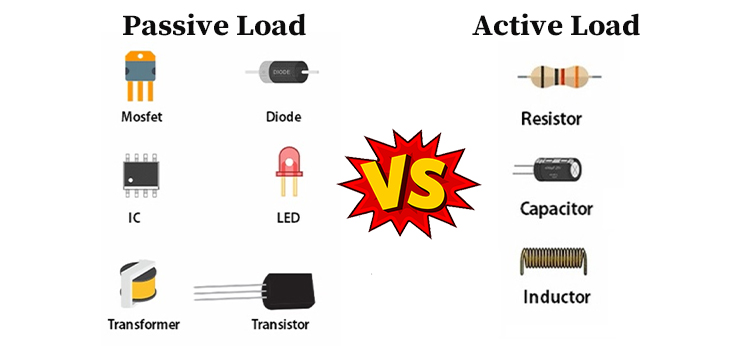What Is Active Load and Passive Load? | Let’s Find Out the Differences
Loads that can supply an average power to some external device for an infinite amount of time, are called Active Loads. On the contrary, Passive Loads can’t deliver any energy. Active loads use additional transistors, mostly FETs, whereas Passive Loads are typically resistors, speakers, and tuned circuits.

What Does Active Loads and Passive Loads Mean?
An active load is a circuit component made up of active devices, such as transistors and amplifiers to supply an average power to some external device. It may be used for signal processing or amplification.

Figure 1: Basic NPN common base circuit with active load
In the NPN circuit of the figure, the current flowing through the resistor of active load from Ohm’s law,
IC=VCC-VOutRC
Passive load is a circuit component made of passive elements such as resistors, capacitors and inductors to dissipate energy as heat or to store energy.

Figure 2: Series RLC circuit
In the series RLC circuit, current flowing through the resistor,
I=VSR+jωL+1jωC
Difference Between Active Load and Passive Load?
Let’s explore the differences between Active Load and Passive Load:
Element Choice
Passive Loads rely on only passive elements to operate. Active Loads require the presence of functional elements such as transistors and amplifiers as well.
Functionality
An active load actively participates in signal processing. It amplifies, modifies, or controls the signal passing through it using active components like transistors or amplifiers.
A passive load absorbs power or energy from a circuit without actively amplifying or modifying the signal. It dissipates energy as heat or stores energy in passive elements.
Complexity and Control
Passive loads only need resistors, capacitors, and inductors. So they are generally more straightforward in design and require fewer components. As active loads require active components like transistors or amplifiers, they require additional circuitry and power sources.
Passive loads generally have limited control or adjustability. Active loads offer more power and adjustability. The active components can be biased, controlled, or adjusted to achieve specific performance requirements.
Examples of Active Load and Passive Load
Here are examples of both active load and passive load:
Active Load
- Transistor
- Operational Amplifier (Op-Amp)
- Field-Effect Transistor (FET) Amplifier
Passive Load
- Resistor
- Capacitor
- Inductor
Frequently Asked Questions and Answers (FAQs)
Is the Resistor an Active Load?
No, a resistor is not an active load. In electronic circuits, resistors are commonly used as passive loads to provide a specific resistance value or to limit current flow. It dissipates electrical energy in the form of heat but does not actively amplify, modify, or control the signal passing through it.
What Is Active Load Torque?
Load torques that have the potential to drive the motor under equilibrium conditions are called active load torques. Such load torques’ sign usually remains unchanged when the drive rotation is changed. Examples: torque due to force of gravity, torque due to tension, torque due to compression and torsion, etc.
What Is Passive Load Torque?
Load torques that always oppose the motion and change their sign on the reversal of motion are called passive load torque—examples: The torque due to friction, cutting, etc.
Conclusion
Even though active loads offer more advantages over passive loads, they are more complex and use more power. The choice between active and passive loads depends on the specific requirements and constraints of the application. So, it’s necessary to carefully consider the pros and cons before using the loads.
Subscribe to our newsletter
& plug into
the world of circuits